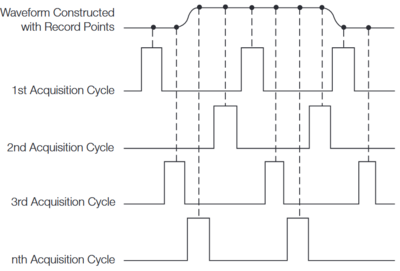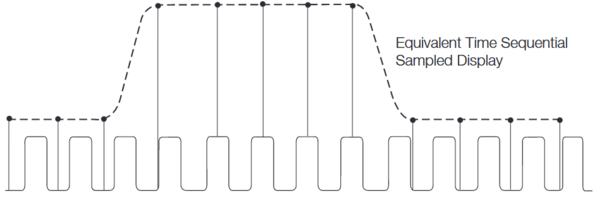Sampling oscilloscope
Tektronix made oscilloscopes and plug-ins intended for sampling measurements. Through the 1960s, the sampling group was led by Al Zimmerman.
A distinction is made between real-time and equivalent time sampling. Real-time sampling requires a sampling rate of at least twice the highest signal bandwidth to capture the signal without artifacts. It is rare with analog oscilloscopes, but the method of choice for low to medium speed digital oscilloscopes, and allows for single shot waveform aquisition.
Equivalent time sampling requires repetitive signals but allows to capture a fast signal with a sampling rate much slower than the signal bandwidth. When talking about a "Sampling Oscilloscope" this approach is usually referred to. However the lines a blurry, since many instruments utilizing sampling concepts switch between different acquisition modes depending on the timebase setting.
Equivalent time sampling is further divided into sequential, and random sampling.
Instruments that have a random sampling mode usually also have a sequential sampling mode, e.g., the 7T11.
Scopes
Plug-ins
Reading
- Sampling Notes, Tektronix
- 50 Years of RF and Microwave Sampling, Mark Kahrs (2003)
- Sampling Oscilloscope Circuits, John Mulvey, Tektronix
- Tektronix S-series Sampling Heads (PDF)
- James R. Andrews, Comparison of Ultra-Fast Rise Sampling Oscilloscopes, Picosecond Pulse Labs Application Note 2a, 1989 (PDF)
- PSPL MTT 2003 paper: 100 GHz Sampler (PDF)
- Construction of a Broadband Universal Sampling Head, J. R. Andrews and G. DeWitte
- Tektronix Sampling Instruments Brochure (PDF)
- Sensitive Sampling Plug-ins Add New Capabilities, Cliff Moulton (PDF, needs OCR)
- February 1965 Service Scope: Sampling Concepts Reviewed
- Media:Cern 61-15 nanosecond sampling oscilloscope.pdf
- Transcript of "Sampling Oscilloscopes and Techniques" Training Film by Norm Winningstad (PDF)
- Introduction to Sampling Concepts (PDF)
- XYZs of Oscilloscopes (PDF)
- High-Speed Measurements Using Sampling Techniques (Student Workbook) (PDF)



